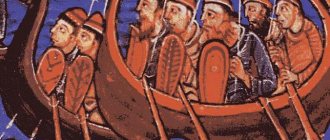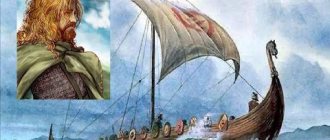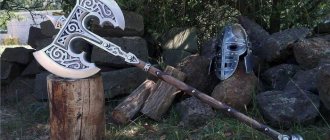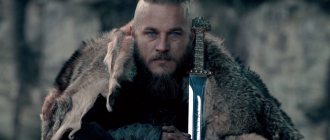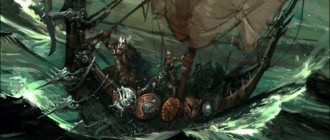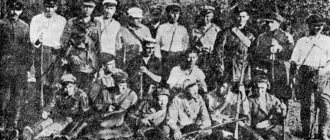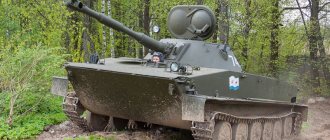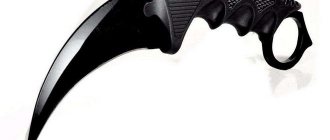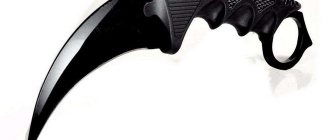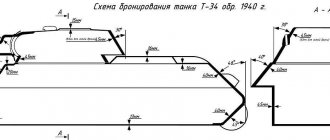Vikings... This word became a common noun several centuries ago. It symbolizes strength, courage, bravery, but few people pay attention to detail. Yes, the Vikings achieved victories and became famous for them for centuries, but they got it not only thanks to their own qualities, but primarily through the use of the most modern and effective weapons.
A little history
The period of several centuries from the 8th to the 11th centuries is called the Viking Age in history. These Scandinavian peoples were distinguished by their militancy, courage and incredible fearlessness. The courage and physical health inherent in warriors were cultivated in all possible ways at that time. During the period of their unconditional superiority, the Vikings achieved great success in martial arts, and it did not matter where the battle took place: on land or at sea. They fought both in coastal areas and deep on the continent. Not only Europe became a battle arena for them. Their presence was also noted by the peoples of North Africa.
Excellence in the details
The Scandinavians fought with neighboring peoples not only for the sake of extraction and enrichment - they founded their settlements on the conquered lands. The Vikings decorated their weapons and armor with unique decorations. This is where artisans demonstrated their art and talent. Today it can be argued that it was in this area that they most fully revealed their skills. Viking weapons belonging to the lower social strata, photos of which amaze even modern craftsmen, depicted entire scenes. What can we say about the weapons of warriors belonging to the highest castes and having a noble origin.
Simple warrior
At first, only a small proportion of Vikings participating in raids could afford expensive weapons and armor. The bulk of the participants in the raids were simple warriors (karls). armed only with an ax or spear and shield. These were free-born Scandinavians, owners of small plots of land who had the right to bear arms. They voluntarily joined an expedition organized by a wealthy compatriot (hersir) or a noble jarl (jarl). and later the king. Many ordinary soldiers were associated with leadership of various kinds of obligations. For these poor peasants, a successful expedition meant real wealth. After deducting a significant percentage to the ship's owner, the remaining spoils were divided equally among the participants.
The participants in the raid armed themselves and equipped themselves. At the same time, the weapons were the simplest, often homemade. Archaeologists believe that each participant in the raid kept personal belongings in his own chest, which also served as a rowing jar. In the absence of the owner, his wife and children, as well as other relatives and slaves, took care of the farm.
| When excavating sites of battles and settlements, archaeologists discover many spearheads of different shapes and sizes. Scandinavian points were usually long and narrow, like the two examples on the right, although their transverse projections are more characteristic of the Carolingian army. The leaf-shaped tip second from the left is characteristic of the Celtic culture. The shape of spearheads remained unchanged throughout the Viking Age. | The Danish ax became the weapon that was firmly associated with the image of the Viking. Even in distant Byzantium, the Varangian Guard was often called the Ax Guard. This warrior, in addition to an ax, is armed with a sword, which is suspended on a sling over his right shoulder. His armor consists of a segmented helmet and chain mail worn over a woolen shirt. | Examples of axes. B or Breidox. Symmetrical axes (right center and bottom) are made of thick hardened steel, connected to a butt made of softer iron. The other four are so-called "bearded axes" or skeggox. Note the ridged shape of the butt, which ensures a tight fit and protects the ax from breaking. It was the Vikings who popularized the ax as a weapon. |
Protection Features
Even the most advanced weapons of those days sometimes could not fulfill their basic functions, because during the battle the Vikings were in fairly close contact with their enemy. The Viking's main defense in battle was a shield, since not every warrior could afford other armor. It protected mainly from throwing weapons. Most of them were large round shields. Their diameter was about a meter. He protected the warrior from his knees to his chin. Often the enemy would deliberately break the shield in order to deprive the Viking of his protection.
Ulfbert, Viking sword
The Vikings were a warlike people, and it is not surprising that their arsenal of weapons was not limited to axes.
The Ulfbert, or Viking sword, was a popular choice, although less common than the axe. In the Middle Ages, iron was available only to wealthy Vikings.
Despite the rarity of swords, the Vikings inflicted a lot of injuries on their opponents with them. The double-sided blade was about 90 centimeters in length, and most often the warrior wore it over his shoulder so that it could be easily grabbed with his right hand.
How was the Viking shield made?
The shield was made of boards 12-15 cm thick, sometimes there were even several layers. They were fastened together with a specially created glue, and the layer was often ordinary shingles. For greater strength, the top of the shield was covered with the skin of killed animals. The edges of the shields were reinforced with bronze or iron plates. The center was the umbon - a semicircle made of iron. He protected the Viking's hand. Let us note that not every person was able to hold such a shield in his hands, and even during a battle. This once again testifies to the incredible physical characteristics of the warriors of those times.
The Viking shield is not just protection, but also a work of art
To prevent a warrior from losing his shield during a battle, they used a narrow belt, the length of which could be adjusted. It was attached from the inside on opposite edges of the shield. If it was necessary to use other weapons, the shield could easily be thrown behind the back. This was also practiced during transitions.
Most of the painted shields were red, but they were also found with various bright paintings, the complexity of which depended on the skill of the artisan.
But like everything that came from ancient times, the shape of the shield underwent changes. And already by the beginning of the 11th century. The warriors acquired so-called almond-shaped shields, which differed favorably from their predecessors in shape, protecting the warrior almost completely up to the middle of the shin. They were also distinguished by significantly lower weight compared to their predecessors. However, they were inconvenient for battles on ships, and they occurred more and more often, and therefore did not become particularly widespread among the Vikings.
Helmet
The warrior's head was usually protected by a helmet. Its original frame was formed by three main stripes: 1 - forehead, 2nd - from forehead to back of head, 3rd - from ear to ear. 4 segments were attached to this base. On the top of the head (in the place where the stripes crossed) there was a very sharp spike. The warrior's face was partially protected by a mask. A chainmail mesh called aventail was attached to the back of the helmet. Special rivets were used to connect the parts of the helmet. Small metal plates were used to form a hemisphere - a helmet cup.
Helmet and social status
At the beginning of the 10th century, the Vikings began wearing conical helmets, and a straight nose plate served to protect the face. Over time, they were replaced by solid-forged helmets with a chin strap. There is an assumption that a fabric or leather lining was fastened inside with rivets. Fabric liners reduced the force of a blow to the head.
Ordinary warriors did not have helmets. Their heads were protected by hats made of fur or thick leather.
The helmets of wealthy owners had decorations and colored markings; they were used to identify warriors in battle. Headdresses with horns, which abound in historical films, were extremely rare. In the Viking Age, they personified higher powers.
Wealthy Warrior (Khersir)
This warrior is called a Hersir - a wealthy landowner who has the status of a local leader or clan chief. At the beginning of the Viking Age, the Hersir were the organizers and leaders of Viking raiding and colonizing forces. Their influence gradually decreased until by the end of the 10th century. Monarchies did not develop in Scandinavia. From this time on, the Hersirs became the king's local representatives.
Apparently, the hersir in the picture is a dual-believer; on his chest he wears a combined amulet, which is a combination of the cross and the hammer of Thor. Such an amulet, dating back to the 10th century, was discovered in Iceland. The story on the shield goes back to Siorri Sturlusson's Elder Edda: two wolves chase the moon and sun across the sky, causing the cycle of day and night. When the wolves catch up with their prey and devour it. the ragna river of the world of Scandinavian mythology will come. Then the fallen warriors left Valhalla and will enter their final battle on the side of the gods of Asgard against the giants. The death of the gods will lead to the final destruction of the world. Perhaps this hersir has even been baptized. Vikings often baptized themselves to improve their ability to trade with Christian peoples. Sometimes they were baptized for the sake of gifts, in other cases they were baptized at the request of the king. At the same time, there was dual faith. On land, the Viking demonstrated his affiliation with Christianity, and at sea he continued to make sacrifices to the pagan gods.
| Hersir carries a sax and two pouches for small accessories on his waist belt. His helmet is complemented by a chain mail aventail, and the sword hilt is a copy of a find made in Hedemarken (Peterson type 5). | Over his chainmail, this warrior wears a lamellar armor that protects his torso. Lamellar armor appeared in the Middle East. The lamella plates from which the shell was assembled could be of different shapes. The warrior's helmet is solidly forged from one piece of iron, but the nose plate is a separate piece. The helmet has a chainmail aventail with a leather lining. This design became widespread in the 11th century. Pay attention to the difference in the diameter of the rings and the thickness of the wire. Archaeological finds indicate a wide variety of rings. | Reconstruction of a helmet from Gjermundby, whose Varangian origin is beyond doubt. It has a chainmail backplate and a face in the shape of a domino mask. The crosshairs of the reinforcing plates are equipped with a small spike. The helmet parts are connected with rivets. Apparently, the helmet belonged to the Varangian leader of the 10th century. Next to the helmet, chain mail and a sword were found. |
| Leather boots fastened with wooden or horn buttons. Additional strips of leather are sewn onto the outsole for better traction. The boots were sewn according to the same pattern as the “turn-out shoes”, but had a higher top. | ||
| Scalloped floor of chain mail. This detail had no practical purpose, but served solely as decoration. Under the chain mail, the hersir wears a woolen shirt and a quilted leather jacket or gabmenzon stuffed with hair, wool, or even hay. | T-shaped chain mail, characteristic of the 8th century. The floors reach to the hips and are decorated with scallops along the bottom. Usually, a quilted gimbeson was worn under the chain mail, which softened the blows. In order not to hinder the warrior’s movements, holes were left in the armpits, which, of course, reduced the protective properties of the chain mail. | Gambenzon with diagonal quilting. Side slits make walking easier. Thick leather gambenzones themselves provided good protection from slashing and cutting blows. There are known gambenzones of the 11th century, sewn from the skin of Lapland reindeer, comparable in strength to chain mail. |
Chainmail
The Vikings spent most of their lives in battle and, therefore, knew that wounds often became inflamed, and treatment was not always qualified, which led to tetanus and blood poisoning, and often death. That is why armor helped to survive in harsh conditions, but allowed one to wear it in the 8th-10th centuries. only wealthy warriors could.
Short-sleeved, thigh-length chain mail was worn by the Vikings in the 8th century.
The clothing and weapons of different classes differed significantly. Ordinary warriors used leather jackets and sewn on bone and later metal plates for protection. Such jackets were able to perfectly repel a blow.
Armor and helmets
The Vikings and their opponents, at least those who could afford it, could wear one of several types of armor. Armor was a very valuable acquisition, since wounds from bladed weapons often caused infection and death in conditions of lack of hygiene and rudimentary knowledge of medicine. Blood poisoning or tetanus were common. Armor made it possible to avoid many injuries, which dramatically increased the likelihood of survival.
Popular opinion states that the Vikings necessarily wore armor. In reality this is not the case. Chain mail (brynja or hringserkr) was expensive armor. therefore, in the VIII - X centuries. only a few Vikings could afford it. Archaeological excavations and surviving images indicate that in the 8th century. Viking chain mail had short sleeves and reached only the upper thigh. For example, 85 fragments of chain mail from the 9th century were discovered in Gjermundby.
Throughout the 11th century. the herd's chain mail is longer. The Bayeux Tapestry depicts Norman and Anglo-Saxon warriors at the Battle of Hastings in 1066, most of them wearing knee-length chain mail (hauberk). The coat of chain mail has a slit at the front and back that reaches the crotch, allowing one to ride in the chain mail on horseback. During this period, the simple T-shaped chain mail became more complex. Added to it was a chain mail balaclava and a face flap that covered the warrior’s throat and lower jaw.
Depending on the size of the knees and the length of the chain mail, from 20,000 to 60,000 rings were needed for one chain mail. The rings were of two types: flat, carved from a megaplastic plate, and bent from wire. Wire spools were also divided into two types: open and closed.
Structurally, the chainmail fabric is divided into groups of five rings, in which four solid rings are connected by one open ring, the ends of which are connected by a rivet. The mass of the 11th century chain mail, which reached the knees and had long sleeves, was about 18 kg. To make such chain mail required the work of a master for a year. Therefore, only a very rich warrior could buy himself chain mail.
It is difficult to say how widespread chain mail really was. Very rarely, chain mail is found in burials. With careful care, the service life of chain mail is practically unlimited; they were passed on from generation to generation. Chainmail was too expensive an item to simply be lost or left on the battlefield. During the Middle Ages, chain mail became widespread, but was still extremely rare in burials, especially since Christianity does not recognize “gifts from beyond the grave.”
| Those who could not afford chain mail made do with a quilted gambeson. Gambenzons are depicted on stones, tapestries and wooden figures. They can be easily identified by the lines of stitches that form a rectangular or diamond pattern. In this case, the gambenzon is made of cloth with a rectangular stitch. | Making chain mail was a very labor-intensive process, but required relatively few tools and could be carried out in almost any forge. The production of chain mail began with cold or hot wire drawing. The wire was wound in a spiral onto a rod and then cut along the rod. The resulting rings were passed through a cone so that the ends of the ring met. The ends of the ring were heated red-hot and then welded by forging. For other rings, the ends were riveted flat and punched through with a punch. Later, adhesive was inserted through this hole. | This reenactor wears T-shaped chainmail with a straight hem and is armed with a saxophone sword. Fragments of such chain mail were discovered in Gjermundby along with a helmet. The rings were about 8.5mm in diameter, with about 24 rings per square inch. Please note that the sleeves are integral with the rest of the chainmail. |
Under the chain mail, a warrior could wear a gambeson of his role, a two-layer shirt made of cloth, leather or linen with a lining made of sheep wool, horsehair or other suitable material. The layers were quilted to prevent the padding from bunching up. Gambeson softened the blows and prevented the chain mail from scratching the body. The leather gambeson itself served as good protection; it was often worn as independent armor.
Mention should also be made of lamellar armor, which is little known in the West since it was invented in the Middle East. But the Vikings, who in their raids reached Byzantium and even visited Baghdad, undoubtedly knew about such armor. The lamellar shell consists of many small iron plates called lamellae. Each plate has several holes. The plates were laid in layers, partially overlapping each other, and connected with a cord. Lamellae of various shapes and sizes were discovered in Birka, a trading town in central Sweden. Although studies have shown that these plates were scattered and did not form a single piece of armor. Apparently, they were kept as supplies.
Another type of armor were striped bracers and leggings. This armor was assembled from metal strips about 16 mm wide and of different lengths. The plates were attached to leather belts. The ancestors of the Vikings also wore armor built on this principle, as evidenced by excavations in Welsgard, Sweden, cultural layers of the 6th-7th centuries.
Particularly valuable component
Subsequently, the length of the chain mail increased. In the 11th century slits appeared on the floors, which was greatly welcomed by the riders. More complex details appeared in the chain mail - a face flap and a balaclava, which helped protect the warrior’s lower jaw and throat. Her weight was 12-18 kg.
The Vikings treated chain mail very carefully, because the life of a warrior often depended on it. Protective robes were of great value, so they were not left on the battlefield and were not lost. Chain mail was often passed down from generation to generation.
Sword
The sword occupies a dominant position in the Viking arsenal. This is an indisputable fact. For warriors, it was not just a weapon that brought inevitable death to the enemy, but also a good friend, providing magical protection. The Vikings perceived all other elements as required for battle, but the sword is a different story. The history of the family was associated with it, it was passed down from generation to generation. The warrior perceived the sword as an integral part of himself.
Viking weapons are often found in warrior burials. The reconstruction allows us to get acquainted with its original appearance.
At the beginning of the Viking Age, patterned forging was widespread, but over time, through the use of better ores and modernization of furnaces, it became possible to produce blades that were more durable and lighter. The shape of the blade also became different. The center of gravity has moved to the handle, and the blades sharply taper towards the end. This weapon made it possible to deliver quick and accurate strikes.
Double-edged swords with rich hilts were the ceremonial weapons of wealthy Scandinavians, but were not practical in battle.
In the 8th–9th centuries. Frankish-style swords appeared in the Vikings' arsenal. They were sharpened on both sides, and the length of the straight blade, tapering to a rounded tip, was slightly less than a meter. This gives reason to believe that such a weapon was also suitable for chopping.
The handles on the swords were of different types; they differed in hilts and head shape. To decorate the handles, silver and bronze were used in the early period, as well as coining.
In the 9th and 10th centuries, the handles were decorated with ornaments made of copper strips and tin. Later, in the designs on the handle, one could find geometric figures on a tin plate, which were inlaid with brass. The contours were emphasized by copper wire.
Thanks to the reconstruction on the middle part of the handle, we can see a handle made of horn, bone or wood.
The scabbard was also made of wood; it was sometimes covered with leather. Inside, the sheath was lined with soft material, which still protected the blade from oxidation products. Often it was oiled leather, waxed cloth or fur.
Surviving Viking Age drawings give us an idea of how the scabbard was worn. At first they were on a sling thrown over the shoulder on the left. Later, the scabbard began to be hung from the waist belt.
About the Vikings and their weapons...
On the bloody sword is a flower made of gold.
The best of rulers Honors his chosen ones. A warrior cannot be dissatisfied with such a magnificent decoration. The warlike ruler increases his glory with his bounty. ("Egil's Saga". Translation by Johannes W. Jensen)
Let's start with the fact that for some reason the Viking theme is being politicized again. “In the West they don’t want to admit that these were pirates and robbers” - I recently had a chance to read something similar at VO. and this only means that the person is poorly informed about what he is writing or that he has been thoroughly brainwashed, which, by the way, is not only done in Ukraine. Because otherwise he would have known that not only in English, but also in Russian there is a book by the Astrel publishing house (this is one of the most popular and accessible publications) “Vikings”, the author of which is the famous English scientist Ian Heath, which was published in the Russian Federation back in 2004. The translation is good, that is, it is written in quite accessible, not at all “scientific” language. and right there on page 4 it is directly written that in Scandinavian written sources the word “Viking” means “piracy” or “raid”, and the one who participates in it is a “Viking”. The etymology of this word is discussed in detail, starting from the meaning of “a pirate hiding in a narrow sea bay” and to “vik” - the geographical name of an area in Norway, which the author considers unlikely. And the book itself begins with a description of the Viking raid on the monastery in Lindisfarne, which was accompanied by robbery and bloodshed. Frankish, Saxon, Slavic, Byzantine, Spanish (Muslim), Greek and Irish names are given - so there’s simply nowhere to go in more detail. It is indicated that the growth of trade in Europe created favorable conditions for piracy, plus the success of the northerners in shipbuilding. So the fact that the Vikings are pirates is said several times in this book, and no one glosses over this circumstance in it. As, in fact, in other publications, both translated into Russian and not translated!
Depiction of events that took place in the 9th century by a Byzantine artist of the 12th century. The miniature shows the imperial bodyguards - Varangs ("Varangian Guard"). It is clearly visible and you can count 18 axes, 7 spears and 4 banners. Miniature from the 16th century Chronicle of John Skylitzes, kept in the National Library in Madrid.
We'll talk about the history of the Vikings some other time. And now, since we are on a military site, it makes sense to consider the weapons of the Vikings, thanks to which (and various other circumstances - who can argue?) They managed to keep Europe at bay for almost three centuries.
Animal head from the Oseberg ship. Museum in Oslo. Norway.
Let's start with the fact that the Viking attacks on England and France at that time were nothing more than a confrontation between infantry arriving at the battlefield on ships and horsemen in heavy weapons, who also tried to arrive at the site of the enemy attack as quickly as possible in order to punish arrogant "northerners". Much of the armor of the troops of the Frankish Carolingian dynasty (named after Charlemagne) was a continuation of the same Roman tradition, only the shields took on the shape of a “reverse drop”, which became traditional for the era of the so-called early Middle Ages. This was largely caused by Charles’s own interest in Latin culture; it is not for nothing that his time is even called the Carolingian Renaissance. On the other hand, the weapons of ordinary soldiers remained traditionally German and consisted of short swords, axes, short spears, and armor was often replaced by a shirt made of two layers of leather and a filling between them, quilted with rivets with convex caps.
The famous weather vane from Soderal. Such weather vanes adorned the prows of Viking longships and were signs of special significance.
Most likely, such “shells” did a good job of blocking lateral blows, although they did not protect against punctures. But the further from the 8th century, the sword became more and more elongated and rounded at the end so that it became possible only to chop. Already at this time, parts of the relics began to be placed in the heads of the handles of swords, which is where the custom of applying the lips to the handle of a sword originated, and not at all because its shape was similar to a cross. So leather armor was most likely no less widespread than metal armor, especially among warriors who did not have a substantial income. And again, probably, in some internecine battles, where the whole matter was decided by the number of combatants, such protection would be sufficient.
"A Thracian woman kills a Varang." Miniature from the 16th century Chronicle of John Skylitzes, kept in the National Library in Madrid. (As you can see, the Varangians were not always treated well in Byzantium. He let go of his hands, and here she is...)
But then, at the end of the 8th century, Norman raids from the North began and European countries entered the three-century “Viking Age”. And it was they who became the factor that most strongly influenced the development of military art among the Franks. It cannot be said that Europe encountered the predatory attacks of the “northern people” for the first time, but the numerous campaigns of the Vikings and their seizure of new lands have now acquired the character of a truly massive expansion, comparable only to the invasion of barbarians on the lands of the Roman Empire. At first the raids were unorganized, and the number of attackers themselves was small. However, even with such forces, the Vikings managed to capture Ireland, England, plunder many cities and monasteries in Europe, and in 845 take Paris. In the 10th century, the Danish kings launched a massive offensive on the continent, while the northern lands of distant Rus', and even imperial Constantinople, suffered the heavy hand of sea robbers!
Across Europe, a feverish collection of so-called “Danish money” begins in order to somehow pay off the invaders or return the lands and cities they seized. But it was also necessary to fight the Vikings, so cavalry, which could be easily transferred from one area to another, turned out to be extremely necessary. This was the main advantage of the Franks in the battle with the Vikings, since the equipment of the Viking warrior, in general, was not very different from the equipment of the Frankish horsemen.
An absolutely fantastic depiction of the victory of the Franks, led by King Louis III and his brother Carloman, over the Vikings in 879. From the Grand Chronicle of France, illustrated by Jean Fouquet. (National Library of France. Paris)
First of all, it was a round wooden shield, the material for which was usually linden boards (where, by the way, its name comes from, “Linden of War”), in the middle of which a metal convex umbon was strengthened. The diameter of the shield was approximately one yard (about 91 cm). Scandinavian sagas often talk about painted shields, and it is interesting that each color on them occupied either a quarter or half of its entire surface. They assembled it by gluing these planks together crosswise, in the middle they strengthened a metal umbon, inside of which there was a shield handle, after which the shield was covered with leather and its edge was also strengthened with either leather or metal. The most popular shield color was red, but it is known that there were yellow, black and white shields, while colors such as blue or green were rarely chosen for painting. All 64 shields found on the famous Gokstad ship were painted yellow and black. There are reports of shields depicting mythological characters and entire scenes, with multi-colored stripes and even... with Christian crosses.
One of 375 rune stones from the 5th–10th centuries. from the island of Gotland in Sweden. This stone below shows a fully equipped ship, followed by a battle scene and warriors marching towards Valhalla!
The Vikings were very fond of poetry, and metaphorical poetry, in which words that were quite ordinary in meaning were replaced by various flowery names associated with them in meaning. This is how shields appeared with the names “Victory Board”, “Network of Spears” (the spear was called the “Shield Fish”), “Tree of Protection” (a direct indication of its functional purpose!), “Sun of War”, “Wall of Hilds” (“ Wall of the Valkyries"), "Land of Arrows", etc.
Next came a helmet with a nosepiece and chain mail with rather short, wide sleeves that did not reach the elbow. But the Vikings’ helmets did not receive such pompous names, although it is known that the helmet of King Adils was called “War Boar”. The helmets had either a conical or hemispherical shape, some of them were equipped with half masks that protected the nose and eyes, and almost every helmet had a simple nosepiece in the form of a rectangular metal plate that went down to the nose. Some helmets had curved eyebrow decoration with silver or copper trim. At the same time, it was customary to paint the surface of the helmet in order to protect it from corrosion and ... “to distinguish friends from strangers.” For the same purpose, a special “combat sign” was painted on it.
The so-called helmet of the “Vendel era” (550 - 793) from a ship burial in Wendel, Upland, Sweden. Exhibited at the History Museum in Stockholm.
The chain mail was called a “shirt of rings,” but just like the shield, it could be given different poetic names, for example, “Blue Shirt,” “Battle Cloth,” “Net of Arrows,” or “Cloak for Combat.” The rings on the Viking chain mail that have survived to this day are made together and overlap each other, like rings for key chains. This technology dramatically accelerated their production, so that chain mail among the “northern people” was not something unusual or too expensive a type of armor. It was looked upon as a "uniform" for a warrior, that's all. Early chain mail had short sleeves and reached to the hips. Longer coats of mail were inconvenient because the Vikings had to row in them. But already in the 11th century, their length, judging by some specimens, increased noticeably. For example, Harald Hardrada's chain mail reached the middle of his calves and was so strong that “no weapon could tear it.” However, it is also known that the Vikings often threw off their chain mail because of their weight. For example, this is exactly what they did before the battle at Stamford Bridge in 1066.
Viking helmet from the University Archaeological Museum in Oslo.
The English historian Christopher Gravett, who analyzed many ancient Norse sagas, proved that due to the fact that the Vikings wore chain mail and shields, most of their wounds occurred on their legs. That is, according to the laws of war (if only war has any laws!) blows to the legs with a sword were completely permitted. That is why, probably, one of its most popular names (well, besides such pompous names as “Long and Sharp”, “Odin’s Flame”, “Golden Handle”, and even ... “Damaging the Battlefield”!) was “Nogokus “- the nickname is very eloquent and explains a lot! At the same time, the best blades were delivered to Scandinavia from France, and there, on the spot, local craftsmen attached handles made of walrus bone, horn and metal to them, the latter usually inlaid with gold, silver or copper wire. The blades were usually also inlaid, and could have writing and patterns laid out on them. Their length was approximately 80-90 cm, and both double-edged and single-edged blades, similar to huge kitchen knives, are known. The latter were most common among the Norwegians, while archaeologists have not found swords of this type in Denmark. However, in both cases they were equipped with longitudinal grooves from the tip to the handle to reduce weight. The hilts of Viking swords were very short and literally squeezed the fighter’s hand between the pommel and the crosshair so that it would not move anywhere in battle. The sheath of the sword is always wooden and covered with leather. The insides were also covered with leather, waxed cloth or sheepskin, and lubricated with oil to protect the blade from rust. Usually, the Vikings depict the sword fastening on the belt as vertical, but it is worth noting that the horizontal position of the sword on the belt is more suitable for the oarsman, in all respects it is more convenient for him, especially if he is on board the ship.
Viking sword with the inscription: "Ulfbert". National Museum in Nuremberg.
The Viking needed a sword not only in battle: he had to die with a sword in his hand, only then could he count on getting to Valhalla, where in the gilded chambers, along with the gods, according to Viking beliefs, valiant warriors feasted.
Another similar blade with the same inscription, from the first half of the 9th century from the National Museum in Nuremberg.
In addition, they had several types of axes, spears (skilled spear throwers were highly respected by the Vikings), and, of course, bows and arrows, from which even kings, who were proud of this skill, shot accurately! It is interesting that for some reason the axes were given either female names associated with the names of gods and goddesses (for example, King Olaf had the ax “Hel” after the name of the goddess of death), or... the names of trolls! But in general, it was enough to put a Viking on a horse so that he would not be inferior to the same Frankish horsemen. That is, chain mail, a helmet and a round shield at that time were quite sufficient means of protection for both the infantryman and the horseman. Moreover, such a weapon system had spread in Europe almost everywhere by the beginning of the 11th century, and chain mail practically replaced armor made of metal scales. Why did it happen? Yes, only because the Hungarians, the last of the Asian nomads who had previously come to Europe, had by this time already settled on the plains of Pannonia and now themselves began to defend it from outside invasions. The threat from mounted archers immediately weakened sharply, and chain mail immediately replaced lamellar armor - more reliable, but also much heavier and not very comfortable to wear. But by this time the crosshairs of swords began to be more and more often bent to the sides, giving them a crescent-shaped side, so that it became more convenient for riders to hold them in their hands, or to lengthen the handle itself, and such changes occurred at that time everywhere and among a variety of peoples! As a result, from about 900, the swords of European warriors became much more convenient compared to the old swords, but most importantly, their number among horsemen in heavy weapons increased significantly.
Sword from Mammen (Jutland, Denmark). National Museum of Denmark, Copenhagen.
At the same time, in order to wield such a sword, a lot of skill was required. After all, they fought with them completely differently from how they show it in our movies. That is, they simply did not fence, but struck rarely, but with all their might, giving importance to the power of each blow, and not their number. They also tried not to hit the sword with the sword, so as not to spoil it, but dodged the blows, or took them on the shield (putting it at an angle) or on the umbon. At the same time, having slipped from the shield, the sword could well wound the enemy in the leg (and this, not to mention specially targeted blows to the legs!), and perhaps this was precisely one of the reasons why the Normans so often called your Nogokus swords!
Stuttgart Psalter. 820-830 Stuttgart. Regional Library of Württemberg. Miniature depicting two Vikings.
Preferring to fight their enemies hand-to-hand, the Vikings, however, also skillfully used bows and arrows, fighting with them both at sea and on land! For example, the Norwegians were considered “famous archers,” and the word “bow” in Sweden sometimes meant the warrior himself. The D-shaped bow found in Ireland measures 73 inches (or 185 cm) long. Up to 40 arrows were carried at the waist in a cylindrical quiver. The arrowheads were made very skillfully and could be either faceted or grooved. As noted here, the Vikings also used several types of axes, as well as the so-called “winged spears” with a crossbar (it did not allow the tip to enter the body too deeply!) and a long faceted tip of a leaf-shaped or triangular shape.
Viking sword hilt. National Museum of Denmark, Copenhagen.
As for how the Vikings acted in battle and what techniques they used, we know that the Vikings’ favorite technique was the “shield wall” - a massive phalanx of warriors built in several (five or more) rows, in which the most well-armed stood in front, and those who had worse weapons stood behind. There is much debate about how such a shield wall was built. Modern literature questions the idea that the shields overlapped each other, as this hindered freedom of movement in battle. However, a 10th-century tombstone at Gosforth from Cumbria contains a relief showing shields overlapping across most of their width, narrowing the front line by 18 inches (45.7 cm) for each man, almost half a meter. It also depicts a shield wall and a tapestry from Oseberg in the 9th century. Modern filmmakers and directors of historical scenes, using reproductions of Viking weapons and formations, have noticed that in a close fight, warriors needed quite a lot of space to swing a sword or ax, so such tightly closed shields are nonsense! Therefore, the hypothesis is supported that, perhaps, they were closed only in the initial position in order to repel the very first blow, and then they opened by themselves and the battle turned into a general fight.
Replica of the axe. According to Petersen's typology Type L or Type M, modeled after the Tower of London.
The Vikings did not shy away from unique heraldry: in particular, they had battle banners with images of dragons and monsters. The Christian king Olaf seemed able to have a standard with the image of a cross, but for some reason he preferred the image of a serpent on it. But most Viking flags bore the image of a raven. However, the latter is understandable, since ravens were considered the birds of Odin himself - the main god of Scandinavian mythology, the ruler of all other gods and the god of war, and was most directly associated with battlefields, over which, as you know, ravens always circled.
Viking axe. Docklands Museum, London.
The most famous Viking hatchet, inlaid with silver and gold, is from Mammen (Jutland, Denmark). Third quarter of the 10th century. Kept in the National Museum of Denmark in Copenhagen.
The basis of the Vikings' combat formation was the same "pig" as that of the Byzantine horsemen - a wedge-shaped formation with a narrowed front part. It was believed that it was invented by none other than Odin himself, which indicates the significance of this tactic for them. Two warriors stood in the first row, three in the second, five in the third, which gave them the opportunity to fight very harmoniously, both together and individually. The Vikings could also build a shield wall not only frontally, but also in the shape of a ring. This was, for example, done by Harald Hardrada at the Battle of Stamford Bridge, where his warriors had to cross swords with the warriors of King Harold Godwinson of England: “a long and rather thin line with wings curving back to touch, forming a wide ring to capture the enemy.” The commanders were protected by a separate wall of shields, whose warriors deflected projectiles flying at them. But the Vikings, like any other infantrymen, were inconvenient to fight with cavalry, although even during retreat they knew how to preserve and quickly restore their formations, and gain time.
Viking saddle pommel from the National Museum of Denmark in Copenhagen.
The Frankish cavalry (the best at that time in Western Europe) inflicted the first defeat on the Vikings at the Battle of Soukort in 881, where they lost 8-9 thousand people. The defeat came as a surprise to them. Although the Franks could have lost this battle. The fact is that they made a serious tactical mistake by scattering their ranks in pursuit of prey, which gave the Vikings the advantage in the counterattack. But the second onslaught of the Franks again drove the Vikings on foot back, although they, despite the losses, did not lose formation. The Franks were also unable to break through the shield wall bristling with long spears. But they could not do anything when the Franks began to throw spears and javelins. Then the Franks proved the superiority of cavalry over infantry to the Vikings more than once. So the Vikings knew the power of cavalry and had their own riders. But they still didn’t have large cavalry units, since it was difficult for them to transport horses on their ships!
Saxon
Viking bladed weapons can also be represented by the Saxon. It was used not only on the battlefield, but also on the farm.
The sax is a knife with a wide spine, the blade of which is sharpened on one side. All Saxons, judging by the results of excavations, can be divided into two groups: long ones, whose length is 50-75 cm, and short ones, up to 35 cm long. It can be argued that the latter are the prototype of daggers, most of which are also brought to the status by modern masters works of art.
Axe
The weapon of the ancient Vikings was an axe. After all, most of the soldiers were not rich, and such an item was available in any household. It is worth noting that the kings also used them in battles. The handle of the ax was 60-90 cm, and the cutting edge was 7-15 cm. At the same time, it was not heavy and allowed maneuvering during the battle.
A Viking weapon, barbed axes, were primarily used in naval battles as they had a square protrusion at the bottom of the blade and were excellent for boarding.
A special place should be given to the ax with a long handle - the ax. The blade of the ax could be up to 30 cm, the handle – 120-180 cm. It was not for nothing that it was the favorite weapon of the Vikings, because in the hands of a strong warrior it became a very formidable weapon, and its impressive appearance immediately undermined the morale of the enemy.
Viking helmets
Not all Vikings wore helmets, but they were a coveted trophy because they provided reliable protection in close combat.
The Viking helmet was quite simple and usually in the form of a bowl with a metal nose guard.
Contrary to popular belief, there is little evidence that Viking helmets were topped with horns, as they are often depicted. The horns did not provide any protection, and on the contrary, the enemy could grab onto them during the battle. The Vikings were pragmatic in their choice of military accessories.
Viking weapons: photos, differences, meanings
The Vikings believed that weapons had magical powers. It was kept for a long time and passed on from generation to generation. Warriors with wealth and position decorated axes and axes with ornaments and precious and non-ferrous metals.
Sometimes the question is asked: what was the main weapon of the Vikings - a sword or an ax? The warriors were fluent in these types of weapons, but the choice always remained with the Viking.
A spear
Viking weapons cannot be imagined without a spear. According to legends and sagas, northern warriors highly revered this type of weapon. Purchasing a spear did not require any special expenses, since they made the shaft themselves, and the tips were easy to manufacture, although they differed in appearance and purpose and did not require a lot of metal.
Any warrior could be armed with a spear. Its small size made it possible to hold it with both two and one hand. Spears were used mainly for close combat, but sometimes also as throwing weapons.
Particular attention should be paid to the spear tips. At first, the Vikings had spears with lancet-shaped tips, the working part of which was flat, with a gradual transition into a small crown. Its length is from 20 to 60 cm. Subsequently, spears with tips of different shapes were encountered, from leaf-shaped to triangular in cross-section.
The Vikings fought on different continents, and their gunsmiths skillfully used elements of enemy weapons in their work. The Viking weapons of 10 centuries ago underwent a change. Spears were no exception. They became more durable due to reinforcement at the transition point to the crown and were quite suitable for ramming attacks.
There was essentially no limit to the perfection of spear handling. It has become a kind of art. The most experienced warriors in this matter not only threw spears with both hands at the same time, but could also catch it on the fly and send it back to the enemy.
Steel arms
Convincing victories of the Vikings over the whole of Europe seem incredible from the point of view of the rather modest arsenal of winners. The Vikings had no superiority in the quality or quantity of weapons over their opponents. In the period from the 7th to the 11th centuries. weapons and equipment were approximately the same throughout Europe, differing only in minor details and quality. Viking weapons were distinguished by their simplicity; almost any weapon (except for a sword!) could also be used as a tool in the household. The ax was used for chopping wood, the spear and bow were used for hunting, and the knife was used as a multi-purpose tool. Only the sword served exclusively the purposes of war.
| Taken by surprise during the robbery, the Vikings took up defensive positions. A warrior in a helmet and a quilted gambeson parries a sword strike with an ax. In the background, the second Viking's shield has been pierced by an axe. Having caught the shield with the beard of the axe, the warrior tries to snatch it out of his hands. That is, the ax was used not only for striking, but also acted as a hook. | Reconstruction of Saxons discovered in England, Ireland and (lower three) Scandinavia. The second sax from the left has a hilt with a guard, but it is too short to be used as a sword, the hilts are made of wood, horn or bone. Some of the Saxons in the picture have handles consisting of two cheeks mounted on rivets, while others have solid handles mounted on a shank. | The warrior is armed with a sword and shield, but also has an ax tucked into his belt from his back. The Arab chronicler Ibn Miskawai describes the Scandinavian warriors who attacked the trading center in 943: each was armed with a sword, but fought with a shield and spear, and also had a knife or ax on his belt. Note the short chain mail with scalloped hem. Helmet with chain mail aventail. |
| "Danish axe" with a long axe. The eccentrically shaped blade became widespread at the end of the 10th century. The cutting edge is from 20 to 30 cm long, although there are references to axes with an edge about 50 cm long. The edge itself was often made of higher quality steel and welded onto the main part of the ax. Like swords, Viking axes sometimes received their own names, often female ones. King Olif Haraldsson named his ax Hel after the Norse goddess of death. In the hands of a tall and physically strong warrior, the ax turned into a devastating weapon, capable of cutting through any armor or knocking a rider off his horse. | A group of warriors is armed not only with long spears, but also with shorter javelins. In the drawings of that time you can see warriors carrying three or four darts. Having thrown darts, the warrior took out a sword or ax with which he continued the battle. Sometimes warriors are depicted holding javelins in the same hand as the shield. Although the spear was a cheap weapon, this does not mean that only the poor were armed with it. Jarls and hersirs could also have a spear, but it was quite decorated. | Although there are expensive and ornate swords, the typical Varangian sword was simple. Few warriors could afford swords with rich decoration. Swords were valued primarily for the quality of the blades, and not for the amount of decorations hung on them. |
Onion
Common during the Viking Age, these weapons were usually made from a single piece of elm, ash or yew. It served for long-distance combat. Bow arrows up to 80 centimeters long were made from birch or coniferous trees, but always old ones. Wide metal tips and special plumage distinguished the Scandinavian arrows.
The length of the wooden part of the bow reached two meters, and the bowstring was most often woven hair. It required enormous strength to operate such weapons, but this is what the Viking warriors were famous for. The arrow hit the enemy at a distance of 200 meters. The Vikings used bows not only in warfare, so the arrowheads were very different, given their purpose.
Viking spears
One with Gungnir's spear at the Library of Congress
There were two types of Viking spears: heavy spears for combat and light throwing spears. The former, however, were more common than the latter, since ranged combat was despised in the North. Spearheads were made of iron and sometimes had designs of copper or silver inserted into their sockets. Battle runes were etched onto them to help in victory.
Up to two meters long, the spears were made from ash, a flexible and durable tree. The tips were leaf-shaped, often with spikes, like a harpoon.
Viking spears sometimes had a purely magical function: they were thrown at the enemy leader or his army at the beginning of the battle, imitating Odin and his spear, as if sacrificing the enemy army to the supreme deity.
Sling
This is also a Viking throwing weapon. It was not difficult to make it with your own hands, since you only needed a rope or belt and a leather “cradle” into which a round-shaped stone was placed. A sufficient number of stones were collected when landing on the coast. Once in the hands of a skilled warrior, the sling is capable of sending a stone to hit an enemy a hundred meters from the Viking. The principle of operation of this weapon is simple. One end of the rope was attached to the warrior’s wrist, and he held the other in his fist. The sling was rotated, increasing the number of revolutions, and the fist was unclenched at maximum. The stone flew in a given direction and struck the enemy.
The Vikings always kept their weapons and armor in order, because they perceived them as part of themselves and understood that the result of the battle depended on it.
Undoubtedly, all of the listed types of weapons helped the Vikings gain fame as invincible warriors, and if the enemies were very afraid of the weapons of the Scandinavians, the owners themselves treated them with great respect and reverence, often giving them names. Many types of weapons that took part in bloody battles were passed down by inheritance and served as a guarantee that the young warrior would be brave and decisive in battle.
Story
The Scandinavians fought with neighboring empires for the sake of mining and establishing their settlements on new lands. The tools were decorated with special decoration by talented artisans, depicting entire scenes. They turned out to be great craftsmen in this area. The equipment of the owners varied depending on their social status. If the origin was noble, then these were swords and axes. If the lower classes, then bows and spears of different sizes.
Most people wonder if this people existed before 789. Of course yes. But practically no one knew about him, since they lived in an area remote from everyone else, where a cool climate prevailed. This unfavorable climate was not conducive to agriculture, which led to large population extinctions in Norway and Scandinavia.
However, starting from the 7th century, due to changes occurring in the atmosphere, the climatic temperature began to rise. Accordingly, a favorable environment for the population appeared and its growth began. This constant increase in numbers in one territory forced residents to leave in search of new places to live, hunt and farm.
In the summer of 789, three Norman ships sailed to the coast of the Kingdom of Wessex. They were tall, fair-haired people, all of them had beards. They were met by an army led by a commander. During the conversation, a disagreement arose between them, which led to a battle. As a result, the leader and the entire local squad were killed, and the visiting strangers sailed away. These were common cases for those times, however, it was from this moment that a new era began.
Four years later, sailors attacked the monastery, which was located off the coast of Great Britain. It was completely destroyed and plundered. Since then, tall men often visited the shores with the aim of robbery and destruction. In 1110, Christianity became widespread in the countries of Scandinavia and Norway. It did not support either murder or robbery, so from that time on, sea raids ceased.
From the Old Norse word, "víkingr" means seafarer, a person from a bay or from a harbour.
The Viking population built their own dwellings with only one room. In its center there were columns holding up the roof. Walls were made from beams. They were coated with clay to insulate the house. In some places where wood was scarce, stone was used. In such stone shelters, peat was used for lubrication instead of clay. The peasants wore shirts, burlap pants, stockings and capes. The upper class wore long pants and socks. The wardrobe necessarily included hats and mittens. The main and successful warriors wore gold or silver jewelry such as bracelets.
These invaders fascinate many of us. During sea voyages, fog was their assistant. Their ships were decorated with dragon heads, called drakars, and were gigantic in size and spacious, light and durable. The sails were impregnated with fat for strength and protection from moisture.
Fearless warriors were famous for their ability to drink large quantities of alcohol, especially during a feast. They liked wine and honey wash. Before the battle, terrible thugs could drink a potion based on fly agarics or a troll drink. It simply blew your mind away, which helped the attackers feel braver and not feel pain.
Scientists have found that the blood of this people flows among residents of Germany, Great Britain, Ireland, Iceland and the Arkhangelsk and Yaroslavl regions. Most people whose ancestors were Vikings live in the small state of Norway. The climate here is moderate; in the mountainous areas you can experience a lot of snow and severe frosts. Thanks to the warm Gulf Stream, a large amount of plankton, and therefore a lot of fish, gathers on the coast.
Modern Norway has gas and oil fields, which helps the country supply itself with such resources. The construction of power plants is favored by rivers and waterfalls. Selling fish and caviar to other countries is one of the sources of income. In addition, tourism activities are developed in the kingdom.

